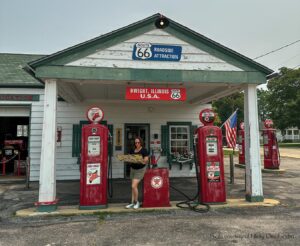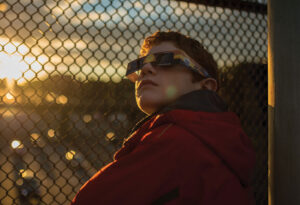I love road trips. In fact, I travel for a living.
For the past two decades, I’ve made a living as a professional writer and photographer, traveling back roads in search of great stories to tell. Planning each trip demands time and effort, so I’m always searching for the latest technology that will make me more productive and efficient. Even though the Internet has streamlined trip planning, on-the-fly changes to trips were not easy. Once plans were in place, it took more work to change them.
Smartphones make road trips much easier and more spontaneous. The paradigm has shifted: Instead of simply carrying a phone, I—like all road trippers now—carry a powerful handheld computer that just happens to make phone calls.
Just as the smartphone has replaced alarm clocks, cameras and wristwatches, it also has taken the place of common travel accessories, like the GPS locator.
Before the smartphone, I used a dedicated GPS unit that I switched from vehicle to vehicle when I traveled. With my iPhone, I have a built-in GPS mapping program that I use to plan trips. Once on the road, the same device gives me turn-by-turn directions until I reach my destination. It not only provides the quickest route to my destination, it also recommends other routes that take me off the beaten path—perfect for the times I want to take the road less traveled.
In addition to mapping, I also prepare for my trip by storing an automobile insurance card on my phone, along with a gas-tracking app that helps me identify the cheapest fuel stops, and a playlist customized to play my favorite traveling songs while I’m on the open road.
Along the way (while I’m stopped, of course), I check out Wikipedia on my phone’s browser. The Wikipedia mobile site is GPS-enabled and will suggest articles about nearby points of interest. You can immerse yourself in local culture by learning more about the people and places nearby.
Smartphones, smart cameras
One of the ways smartphones excel is as both a still and video camera. You no longer require a dedicated camera to capture your travel memories. Sales figures indicate consumers have figured this out. In 2013, camera-enabled smartphone sales topped 1 billion—a 38 percent increase over the previous year, according to a report in PCWorld. During the same time, digital camera sales dropped 36 percent, mostly in the mid- and low-priced models. The trend is clear.
For photography, the in-phone camera app is the best place to start. The phone I use has settings for standard images in the 4:3 format and square format, and it includes a panorama setting. I use the panorama mode to take wide-angle shots from the road and to capture the broad vistas that smaller formats can’t.
While the standard camera settings are fine for most uses, I often use apps that utilize the camera and the processing power of the phone’s computer to give pictures a vintage feel. Even though Hipstamatic is my favorite app, there are several others available in the Apple, Android or Google formats that add effects like filters, filmstrip borders, frames, light leaks and other creative embellishments.
For the traveler, one of the greatest tricks that a smartphone camera performs is embedding GPS information in each picture. Now, instead of guessing where pictures were taken once you’re back home, you can rely on any one of several low-cost photo-management software solutions to extract the GPS location from the photo and pinpoint the location on a software-generated map. These maps save the key points of a trip and help you relive and share the memories later.
In addition to shooting still photos, smartphones also are equipped with high-definition video cameras. I use my HD phone camera sparingly because I own dedicated high-definition video cameras that I prefer. However, the smartphone can produce impressive video. The smartphone offers the ability to shoot slow motion, use apps to record video with a vintage 8mm look and do on-the-fly editing along with seamless posting to social sites like YouTube or Facebook.
Stay connected
Speaking of sharing, wouldn’t it be nice if you could take a picture on Integra and cross-post to other social platforms so you can keep in touch with all of your family, friends and followers? You can. All it takes is a single touch of the screen.
Most social apps have the ability to cross-post to a variety of networks. If you post to one site, you can post to many other social accounts on the go, all at once. It is a real time-saver.
Staying connected has advantages beyond social interactions. When you are away on your travels, you can completely monitor your home from the road. Most security companies offer ways to monitor your home alarm and watch home-security cameras using your smartphone. You can also check to see whether doors are locked, close or open garage doors and activate or adjust the thermostat from the phone.
I use a Nest thermostat system that I can turn off when I leave. Half an hour or so before I arrive home, I can log in from my phone and turn on the heat or air conditioning so the house is comfortable when I walk in the front door after a trip.
Television providers also have technology that allows customers to set and manage recordings from a smart device. Gone are the days of missing your favorite show or the big game because you are driving in the countryside. From anywhere I have cellphone or Wi-Fi service, I can log in to my Dish Network account, set my home DVR to record a show and either enjoy it from my phone while I am away or watch it when I get home.
Extending your trip longer than you’d initially planned? Use your smartphone to connect to your bank account and transfer money from one account to another or pay your bills remotely.
Make a note of that
While it goes without saying that you should not divert your attention from the road by looking at your phone, you easily can use the notes or audio memo app on your phone to speak and record your thoughts. Recording an audio memo is just like it sounds: You talk to the phone and it records your voice.
The notes or other speech-recognition apps such as Dragon make trip journaling easy. Using voice-recognition capability built into your phone, you can speak to the phone, and the software transcribes speech to text on the screen. When you get home and you are ready to put your notes with photos or videos, it’s easy to email your notes, edit them in word-processing software and then copy and paste them into a book layout or any other presentation method of your choosing.
I’ve found that I often speak to my phone and take notes on topics of interest that I’ve seen, story ideas, great restaurants or various musings that come to mind. The ability to take notes without physically writing something down has really increased my efficiency.
Eating and sleeping on the go
If you’re like many travelers, the most important questions you face are, “Where am I going to stay?” and “What am I going to eat?” Not too long ago, staying in a hotel or eating at a restaurant with which you were unfamiliar was a hit-or-miss proposition. Even if you are choosing among locations of a national food or lodging chain, local management can make a significant difference in your experience. That’s where the crowd can help.
Many downloadable apps double as a social network that offers input on lodging and eating establishments. The hotels.com app finds available lodging in a given area, publishes the price and provides user-generated feedback about the quality of the hotel’s amenities. Once you’ve found a place you like, you can book it from your phone in a matter of seconds.
The Yelp app works in much the same way that hotel apps work. Except with Yelp, the mainstay is providing crowd-sourced reviews of restaurants by giving patrons an opportunity to rate the establishment and provide feedback about the quality of food and service. Take the time to read the reviews and gather as much information as possible. I’ve found some great local eateries this way, and you can, too.
The bottom line is that the technology in your hand lets you focus less on planning and more on traveling. Smartphones are an indispensable tool for road trippers.
The best tip? When you get to that cool destination, be sure to turn off your phone for a while and enjoy the trip.
Travel technology at a glance
The purpose of technology is to make our lives easier. With that in mind, smartphones help every traveler spend less time planning and more time enjoying the trip and making memories.
Here’s a list of apps and smartphone functions that can make your travel easier:
Planning
Apple Maps: This app is built in to the iPhone and is proprietary to the Apple device. For other phones, Google Maps is a good alternative. Each will map out point-to-point directions and guide you along your route.
Gas Buddy: This app and others like it use the location service on your phone to track your whereabouts and tell you the cheapest gas prices nearby.
Insurance: Most insurance providers offer apps that let you carry your auto insurance on your phone. It’s a great time-saver when you need to present up-to-date coverage information.
Information
I default to the Wikipedia app to update information. I love its encyclopedic format and the way it uses the GPS location to suggest local articles. It’s a great way to research the local history that makes your trip more interesting.
Photography
Use your camera app for general photography because smartphones are as good as point-and-shoot cameras. GPS-enabled smartphones can geo-tag your images so you know precisely where they were taken. It’s a great way to preserve the memories of a trip.
There is a ton of information online to learn how to become an accomplished smartphone photographer. Verizonwireless.com is an especially helpful website. Type “nick-lavecchia-morningcoffee” in the search field and get tips from a professional photographer.
Hipstamatic: This phone app uses your built-in camera and adds cool, artistic embellishments to the photos. I love the way it gives my images a vintage feel, and I take most of my on-the-road images using this app.
Super 8: When I shoot video on my smartphone, I often use the Super 8 app, which takes my high-def phone camera footage and makes it look like it was shot by a Super 8 camera from back in the 1970s.
While you’re away
Home security: The Nest app connects to my Nest home thermostat so I can control the air and heat while I’m away. The house is at the perfect temperature when I arrive home.
The “connected home” is not the name of any specific app, but it does describe the incredible technology that’s available. With a smartphone, you can use apps to control security cameras in your home, lock doors, check garage doors and even set your digital video recorder.
Enjoy the trip
Journaling and social networking: Notes is an integrated app on my Apple iPhone with which I can type up random thoughts while I’m out of the car. What’s really cool is that I can talk to the phone and it transcribes my words into text.
Facebook, Twitter and Instagram: These social networking sites all have apps so you can post your adventures on the go. With Instagram, you can cross-post to Facebook, Twitter, Tumblr, Flickr and Foursquare. So instead of wasting a lot of time posting to multiple accounts, you can post to one and you’re done.
Yelp: Yelp is a great way to discover local eateries. Using real user reviews, Yelp rates restaurants. Using the geo-location services built into your phone, Yelp determines your location and makes recommendations on where to eat.
Hotels.com: This app finds a place to lay your head. Like Yelp, the app provides prices and user ratings, and it allows you to book your hotel immediately.
Kids: Consider having games—Angry Birds or Minecraft Pocket Edition come to mind—and playlists of songs your children like at the ready for the times when the kids get antsy in the car.
Last but not least
Chargers: Finally, you need to keep your phone charged. Use your car charger when possible. If you get away from your vehicle—on a remote camping trip, for example—consider using a portable solar panel or a battery extender to help you keep your charge.








